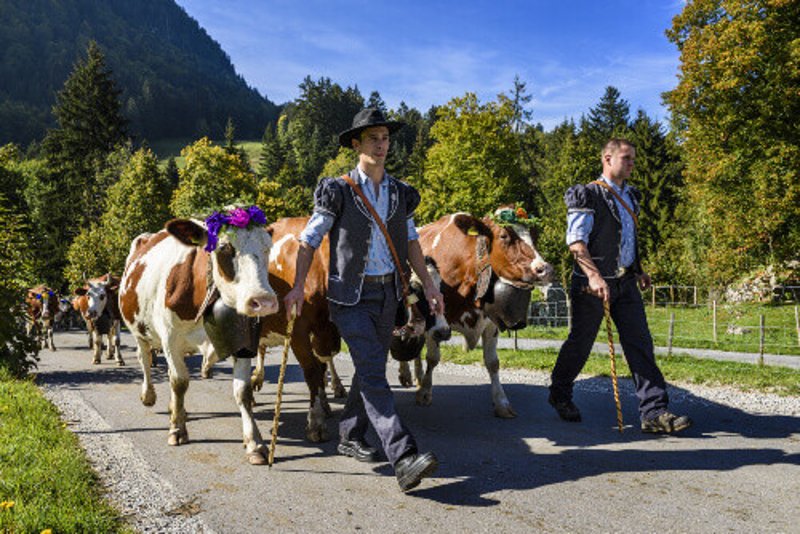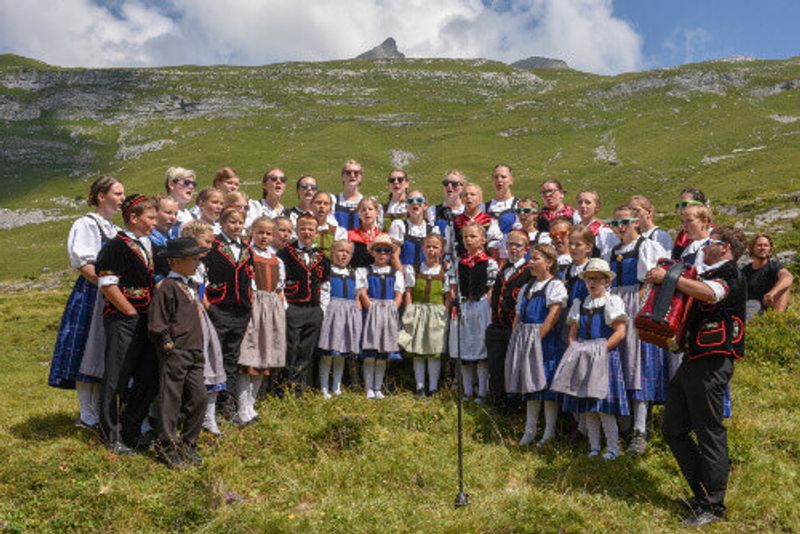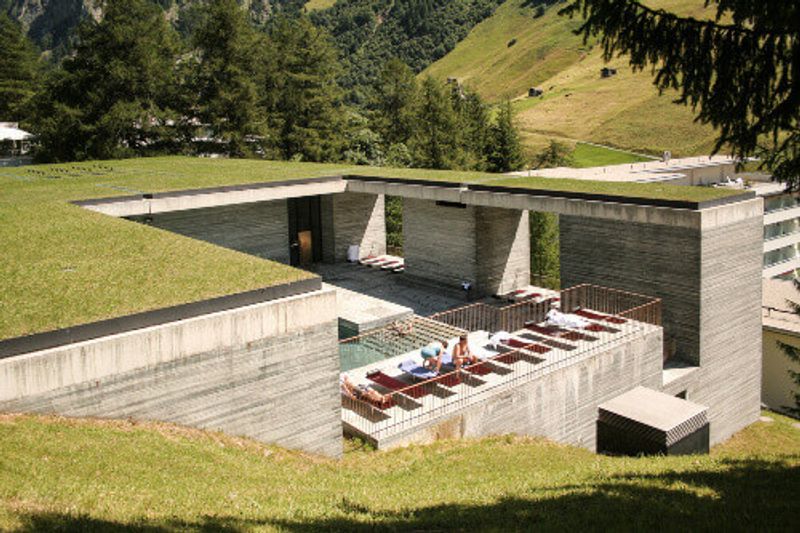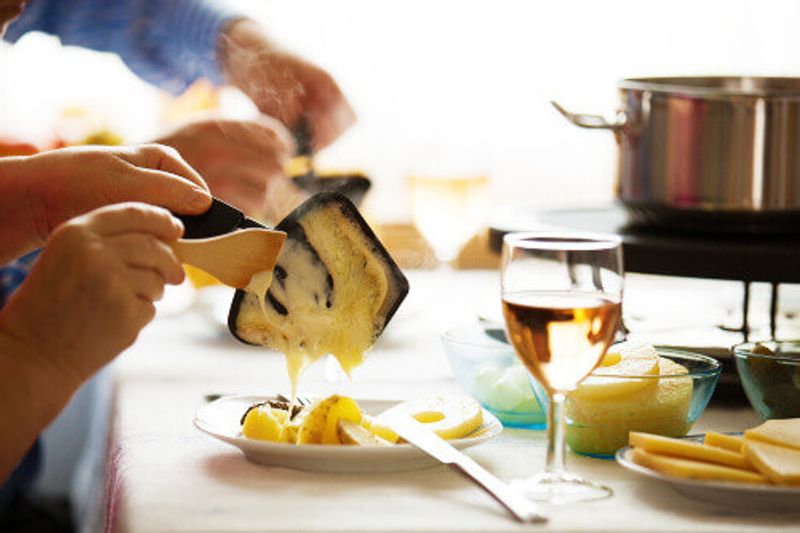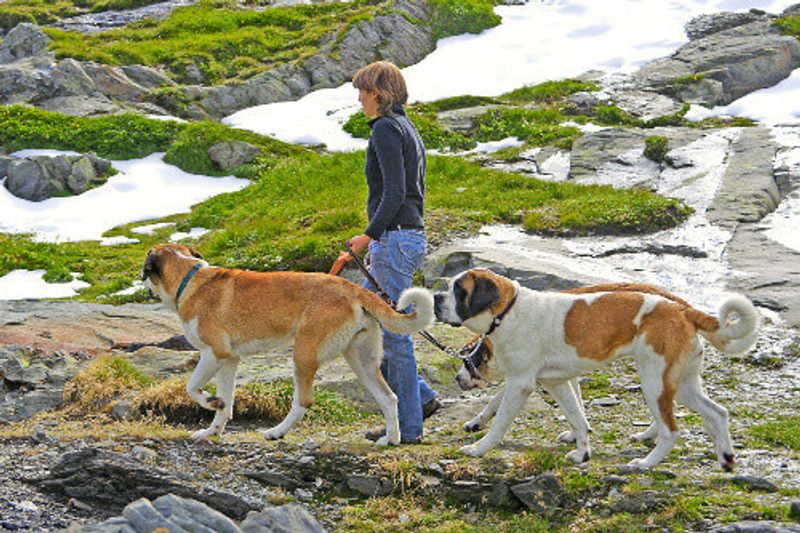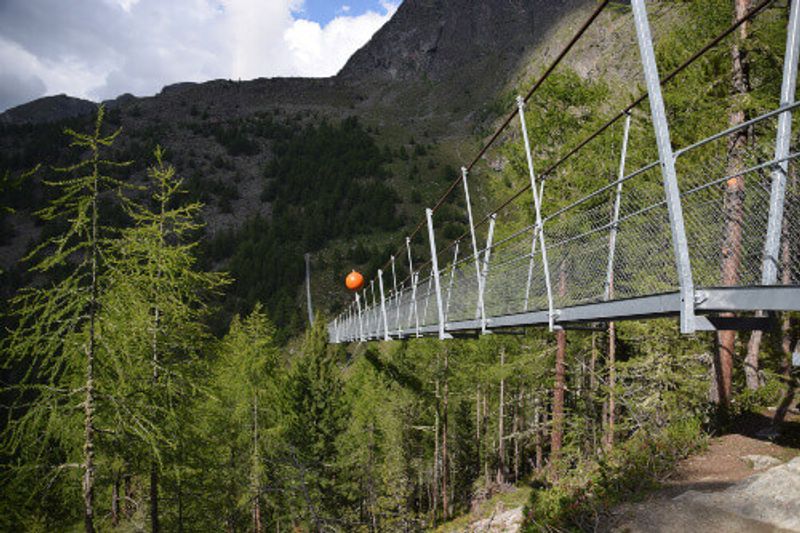There’s a whole lot more to an Alpine adventure than photo ops and skiing. Here are seven quintessentially Swiss experiences you can only find in the Alps
From celebrating cows in a town famous for its cheese and soaking in thermal baths, to hiking with St Bernards (yes, the dogs) and crossing the world’s largest suspension bridge, the Swiss Alps have a little something for everyone.
Here, a selection to put you in the mood for a Swiss adventure.
Celebrating Alpine cows in Gruyères
It’s no secret that happy cows produce the best milk (and therefore the best cheese), and are there any happier cows in the world than in the Swiss Alps?
Cattle are so beloved in Switzerland that there are festivals – known as the Désalpe – held throughout the country in autumn in their honour. Charmey in the Gruyères region puts on a brilliant show, where farmers lead their herds down from the mountains and into the valley in preparation for the winter ahead.
Adorned in wreaths and floral crowns, the cows parade through the town while locals, decked out in traditional dress - Bredzon for men and the Dzaquillon for women – join in this celebration of Swiss agriculture. When the cows are safely tucked in for winter, everyone else sticks around to enjoy traditional music, dancing, wine and, of course, cheese.
Listen to yodelling
There is no sound more stereotypically Swiss than the Yodel, or jodel, bouncing off jagged snow-capped peaks.
Fränzi Meyer of the Swiss Yodeling Association says: “The yodelling itself, without words, is a very old language from the mountains to communicate with neighbours and the good Lord. A natural Yodel springs directly from the heart, sounds through the throat, and leads to the sky.”
While versions of this lyric-less, vowel heavy singing is found throughout the world, it began in the Alps as a way for shepherds to quickly communicate to cattle and neighbours across the vast expanses of mountains and valleys. If you’re lucky enough to catch one of Switzerland’s yodelling festivals or choir performing from atop a peak - bonus points if it's accompanied by the alphorn, the Alps’ very own long, wooden horn - the experience will be as unforgettable as the accompanying scenery.
Hitch a ride on the glacier express
Affectionately dubbed ‘the world’s slowest express train,’ the indescribable views along this route will make you wish the eight-hour journey from Zermatt to St. Moritz will never end. Whether you’re travelling first, second or springing for Excellence Class, the panoramic windows in each section of this specially designed train guarantee stunning scenery as you progress along a route that includes 91 tunnels and nearly 291 bridges.
Setting off from Zermatt at 1605 m, the start of the journey takes in the Matterhorn and some of the highest and most dramatic peaks in the Swiss Alps. From there you’ll wind your way through the river-carved landscapes of the Rhine Gorge (also known as the Grand Canyon of Switzerland) and through the castle-dotted Domleschg Valley. You’ll pass by the spectacular and iconic Landwasser viaduct – where the train even slows down for prime photo opportunities. After climbing again to 1800 m, you’ll travel through the Albula tunnel and emerge into the majestic Engadine Valley before pulling in at the most elegant ski resort in Switzerland, St. Moritz.
Soak in a natural thermal bath
Whether it’s after a day of skiing or sedentary train travel, soaking your muscles in one of Switzerland’s natural thermal baths while surrounded by some of its most iconic peaks is the ultimate Alpine luxury.
Treat your mind, body and soul to a day in the Lower Engadine’s Bad Engadin in Scuol; there are 10 natural springs in the area supplying drinking water and local bads (the German word for bath), all of which are wonderfully relaxing and restorative.
For a particularly memorable experience, try the classic Roman-Irish Bath at Bad Engadin, which combines the hot, dry air of a sauna favoured by the Irish with the Roman method of dipping into steamy baths of various temperatures.
Go beyond fondue
Don’t get us wrong, there are few things better than dipping bread into a vat of melted cheese after a day spent in the mountains, but it’s not the only dish on offer – and certainly not the only one dominated by cheese.
Swiss native and food enthusiast, Audrey Laurencet, boasts about one of her country’s slightly lesser-known national dishes.
“You must try the Raclette from Valais, and pair with one of the delicious local white wines, which are just as delicious as an aperitif in the sun,” she says.
Some say there is no better way to enjoy the view of the Matterhorn in Zermatt – located in the Swiss-German canton of Wallis or Valais – than indulging in this traditional communal meal. Served with potatoes or bread, onions, cured meats and gherkins, raclette comes from the French verb racler; to scrape. To make the dish, one side of a wheel of cheese is held to a flame, and the ‘host’ then scrapes off the melted bits onto the potatoes on guest’s plates. Yum!
Hiking with St Bernards in the Great Saint Bernhard Pass
Other than dairy cows, is there another animal more synonymous with the Swiss Alps than the loyal St. Bernard? Augustinian monks in this area of the Western Alps have bred these huge, slobbery, loveable dogs since the Middle Ages, where they became successful avalanche rescue dogs.
Today, the dogs are no longer bred at the shelter, or ‘hospice’, located at the highest point on the Great Saint Bernhard Pass – the third highest pass in Switzerland. Instead, the dogs happily spend their days in the fresh air and beauty of the Alps. In the summer months, visitors can hike and play with these gentle giants – just don’t forget to give them back when your time is up.
Cross the world’s largest suspension bridge
Building their way across, through, and under the country’s many mountains and lakes has made the Swiss some of the most skilled engineers in the world.
To experience this first-hand, while still taking in some picture-perfect views of the Matterhorn, try walking across the world’s longest suspension bridge between Zermatt and Grächen – provided you are not scared of heights, that is.
Part of the Europaweg hiking trail, you’ll stroll above the valley 85 m high, with 495 m to go until your feet touch solid ground again. The bridge is only a couple of years old but already it has made headlines around the world for its gravity-defying, one-of-a-kind views. When you see it, you’ll realise why.
